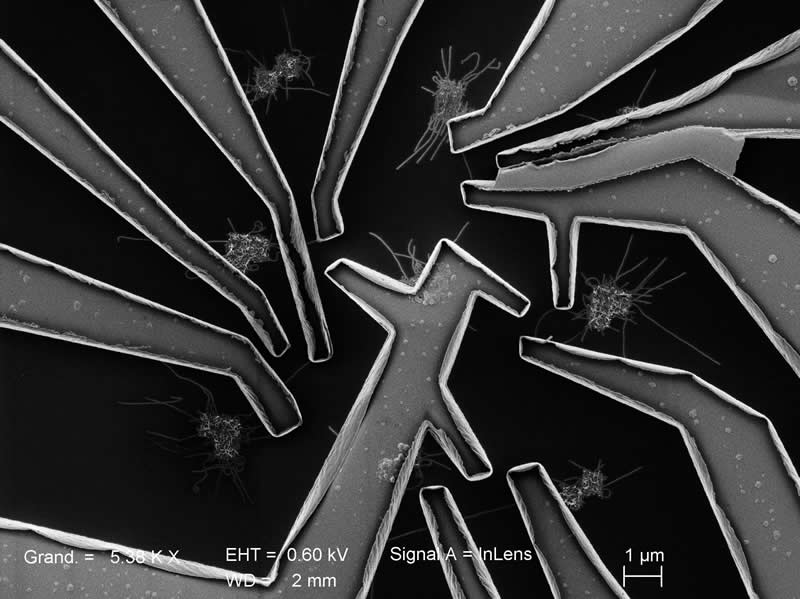


In order to test this proximity superconductivity – the extension of superconducting properties out of a superconductor – a non-superconducting conductor (a “normal” conductor) can be placed between two superconducting contacts. In order for superconductivity to go through the “normal” conductor, this conductor has to be “quantum coherent”.
This means that if two electrons forming a Cooper pair go from the superconductor to the normal metal, they have to stay in the same quantum state while they go through the normal metal in order to be able to form a superconducting pair in the second superconductor. Hence, the paired electrons have to be subjected to the same interactions while going through the “normal” metal, and their state must not change because of thermal agitation or an interaction with a magnetic atom that would affect the two electrons of the pair differently.
In order to test if this is the case, we measure the resistance of the entire Superconductor – non-superconducting Normal Metal – Superconductor sandwich, which is called S-N-S: if the non-superconducting conductor “N” is quantum coherent to the temperatures of the experiment, the resistance of the SNS junction drops to zero, even for important normal metal length (several thousands nanometres at temperatures lower than a Kelvin, cf. figures).
This test probes the nature of the normal conductor and of the electron pairs that can go through it. This is how we can predict a new type of pairs able to go through graphene* (cf. figure). It has also been recently discovered that electron pairs can change their spin configuration going through a few dozen nanometre long magnetic material.
 Graphene
Graphene
This carpet square is in fact a square micron of graphene, a one atom thick material discovered in 2004, which enabled its inventors to win the Nobel Prize in 2010. At a low temperature, when contacts are superconducting, a one-microampere supercurrent can flow and can be controlled with a gate voltage.Carbon nanotubes
 Carbon nanotubes
Carbon nanotubes
The long wires that can be seen (in black) going from one edge to the other are carbon nanotubes with a 1-nanometre diameter (about only ten atoms!), with alengthof several hundredsnanometres.These nanotubes areconnected to superconductingelectrodes  thanks tonano-welding, and are hanging above space,so that they can be observed with a transmission electron microscope. At a low temperature, a supercurrent of 0.1 microampere can flow through these nanotubes
thanks tonano-welding, and are hanging above space,so that they can be observed with a transmission electron microscope. At a low temperature, a supercurrent of 0.1 microampere can flow through these nanotubes
Proximity superconductivity can even be created in hundreds square microns, sparkling superconducting nanoparticles on the surface of the graphene.
 Molecules
Molecules
Picture (taken with a transmission electron microscope) of two C82 molecules (kinds of footballs composed of carbon atoms), filled with only one magnetic atom (each molecule contains a gadolinium atom). On this micrograph, we can see that the two molecules are hanging in space, between two superconducting contacts. This is how we study how the electronic spins – the smallest existing magnets – contained in the two molecules prevent superconductivity to go through the two molecules perfectly. This picture is one of the only examples of molecular system that could be electrically measured and observed with such a resolution with a microscope.
 Only one atom ?!
Only one atom ?!
Quantronic image: We can make a supercurrent flow through only one atom (an aluminium atom for instance): here the bridge we can see can be very progressively opened or closed until it only consists in only one atom linking the two superconducting electrodes. http://iramis.cea.fr/drecam/spec/Pres/Quantro/static/projects/josephson-effects-in-atomic-contacts/index.html
